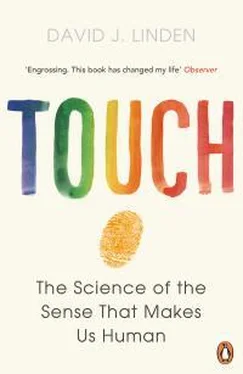In addition to the sensory nerves carrying touch information to the brain, there are autonomic nerve fibers that enable the brain to actually alter the properties of the skin. One’s emotional state can produce subconscious activation of the autonomic nervous system to affect sweating and local blood flow and erect the hairs on our skin, particularly on the arms. (Of course these emotionally driven skin changes are accompanied by other bodily changes: respiration, heart rate, core muscle tone, and so on.) When our emotional state changes our skin—say, by making us sweat or erecting hairs—it has reverberating effects on interpersonal touch. The caress and other sensors that are activated by erect hairs encode movements differently from ones that lie flat. Likewise, a layer of sweat will affect the way your texture and pressure sensors will be activated as you explore your partner’s skin. These subconscious changes in skin properties will cause your skin to feel different to your partner as well, and your own emotional state will be modulated by your perception of your partner’s reaction to touching you. It’s not just a meeting of minds or a meeting of skins, but a dual dialogue between mind and skin that, in the best of cases, reverberates from one body to the other in a positive way. 19

Our body schema—the brain’s internal map of our body in space—can expand and morph to encompass inanimate objects that we touch and control. This explains why we instinctively duck our heads when driving a vehicle that barely clears an overpass, and why Texas politicians sporting cowboy hats duck their heads when going through Capitol doorways—their hats have become automatic extensions of their bodies. Similarly, the body schema of a ditch digger comes to include her shovel, and a violinist, her bow, each of which can come to function as a tactile sensory appendage. 20But these useful yet odd effects on body schema are not limited to things that we actually touch. We can respond to sensory stimuli that don’t impinge on our bodies at all.
When my children were small, they would delight in being tickled again and again. Soon I came to learn what all parents know: Once your kids have been tickled a few times and are all wound up, you don’t even have to touch them to make them convulse with ticklish laughter. Wiggling your fingers a few inches above the ribs will usually do the trick. The effect works even better if you make a noise that becomes associated with the tickling (I would make a high-pitched whine like the sound of a hummingbird) and then repeat that noise while fake tickling. While most adults lose this sensitivity to fake tickling, some retain it into adulthood.
The modern adult equivalent of fake tickling is the phantom cell phone vibration. In a recent survey of medical staff at an academic medical center in Massachusetts, 68 percent of cell phone users reported sometimes feeling the sensation of a vibrating cell phone when in fact the phone was not actually vibrating—or, in some cases, not even being carried. Thirteen percent of the survey’s respondents reported feeling phantom cell phone vibrations at least once per day. Those who carried the phone in a breast pocket were more likely to experience phantom vibrations than those who used a belt clip. 21While fake tickling is a nontouch stimulus (involving sight and sound) that is perceived as touch, phantom cell phone vibration results from no stimulus at all and hence qualifies as a full-blown hallucination. Both fake tickling and phantom cell phone vibrations are the products of expectation based on prior individual experience. If these phenomena were examined in the brain scanner, it’s likely that both would show activation of the appropriate site in the body map of the primary somatosensory cortex.
“By the pricking of my thumbs,
Something wicked this way comes.”
—William Shakespeare, Macbeth , act 4, scene 1, spoken by the Second Witch 22
People love to talk about mysterious tactile sensations, much like the foreboding of Shakespeare’s witch.
“My grandpa can feel changes in the weather coming with his arthritic knee.”
“I always have an itchy feeling on my neck before bad news arrives.”
Such claims are typically delivered in an awed (or sometimes emphatic) tone of voice. The implication is that these are phenomena that cannot be explained solely by understanding the natural world but require supernatural explanations of one form or another. In the case of the arthritic knee, one could imagine that changes in barometric pressure that precede weather events might subtly alter the conformation of tissues in the knee, thereby providing a naturalistic explanation. However, the bulk of evidence is weighed against this idea: Despite widely held beliefs 23that have persisted since the time of Hippocrates (approximately 400 BC), research has not established a clear association between arthritis pain and the weather. 24In the case of the prescient itchy neck, the most likely explanation is recollection bias: The times when an itchy neck was not followed by bad news are forgotten, and only the confirming cases are recalled, leading to a spurious correlation.
As you can tell, like most scientists, I’m skeptical about such claims. But only a week ago I was in a restaurant when I felt a weird prickly sensation on the back of my head, which gave me the strong sensation of being watched. I turned around and, sure enough, two booths away, an elderly couple was looking directly at me. I waved, their eyes darted down to their plates, and life went on. We’ve all experienced the tactile feeling of being watched. Certainly recollection bias plays a role here. I tend to remember the times when I turned around to find myself being watched but fail to recall the times when I turned around to find no one looking at me. That said, I don’t believe that recollection bias is a complete explanation of the phenomenon.
It’s been well established that when deprived of all relevant sensory information in the laboratory, we cannot detect someone’s presence behind us, much less their gaze. But in the real world, we’re not subject to such extreme deprivation. We can detect objects and motion at the edges of our visual field that do not enter our conscious perception. When an event is completely outside our visual field, we often sense other cues, like the sound of halted or hushed conversation or changes in air pressure when the door to a room is opened. Crucially, we do not need to be consciously attending to these sensory cues for them to affect our perception. Just as with the phantom cell phone vibration, when we hear an ongoing conversation stop or change rhythm or volume behind us, or when we feel the subtle breeze that accompanies a door opening, our brain makes an inference based upon past experience and creates a tactile sensation where none exists. In my case, such a signal accounted for the tingling I felt at the back of my head.
When confronted with experiences that are deeply emotional, transporting, or counterintuitive, it is a fundamentally human response to seek explanations beyond the natural world. Touch is intrinsically emotional, and so the experience of touch is often subject to such inclinations. Yet the supernatural is not required to explain mysterious or transcendent touch sensations.
Whether it involves the electric touch of romantic love, the unsettling feeling of being watched, the relief of pain from mindful practice, or the essential touch that newborns need to thrive and communities need to cohere, the transcendent aspect of touch prevails when we understand that these feelings flow from the evolved nature of our skin, nerves, and brain. Ultimately, the biology of touch shows us that the natural is as deeply human and humane as the supernatural.
Читать дальше













